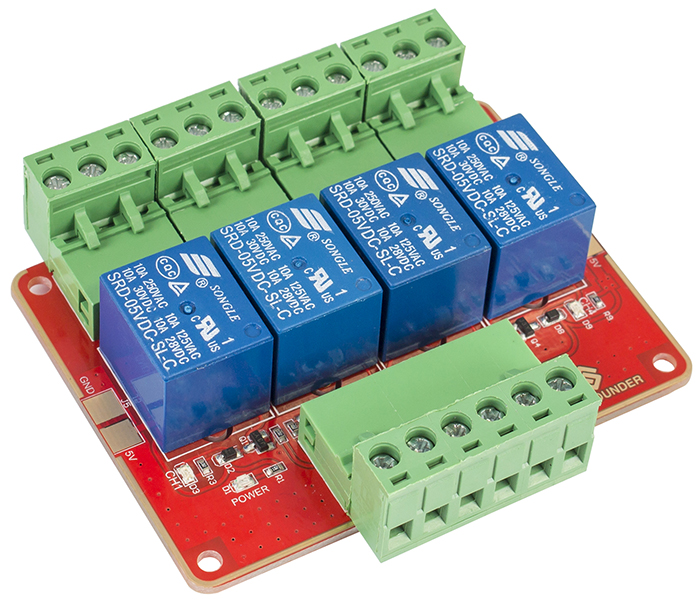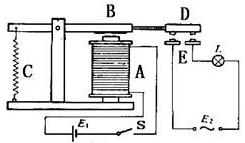Difference between revisions of "4-Channel High Level Trigger Relay"
| Line 1: | Line 1: | ||
=='''Introduction'''== | =='''Introduction'''== | ||
| + | This is a 4-channel HIGH level trigger relay, applicable to Arduino and Raspberry Pi, Relays are suitable for driving high power electronic devices such as lights, electric fans and air conditions, | ||
| + | There are two soldering points for 5V and GND at the two ends of the module. So you can just weld other relay modules to it and have a relay module of more channels, signals of which are independent of each other. | ||
| + | You can just unplug the headers to disconnect the device with the module after the experiment and don't need to unscrew the wires in the socket. Kindly reminder: Be careful with your fingers when unplugging the headers. | ||
[[File:4channel_relay.jpg]] | [[File:4channel_relay.jpg]] | ||
| − | + | Sending a HIGH level to SIG; the NPN transistor is energized and the coil of the relay is electrified. Thus, the normally open contact of the relay is closed, while the normally closed contact of the relay will be open. Send a LOW level to SIG; the transistor will be de-energized and the relay will restore to the initial state.<br> | |
| − | + | ||
The schematic of the relay module is shown as following: | The schematic of the relay module is shown as following: | ||
| − | [[File: | + | [https://www.sunfounder.com/wiki/index.php?title=File:4_channel_HIGH_Relay_Schematic.pdf 4_channel_HIGH_Relay_Schematic][[File:PDF.jpg]] |
| − | + | ||
| + | =='''Features'''== | ||
| + | 1) Support control of 10A 30V DC and 10A 250V AC signals | ||
| + | 2) 5V 4-Channel Relay interface board, and each one needs 15-20mA Driver Current | ||
| + | 3) HIGH level trigger, with indicator LEDs showing working status | ||
| + | 4) With two soldering points for 5V and GND, the module can be extended to 6- or 8-channel relay one with other relay modules | ||
| + | 5) Working voltage: 5V; PCB size: 5.6 x 7.5 cm ->2.20 inch x 2.95 inch | ||
=='''Principle of relay'''== | =='''Principle of relay'''== | ||
| Line 18: | Line 26: | ||
Add a certain voltage to the coil and some currents will pass through the coil thus generating the electromagnetic effect. So the armature overcomes the tension of the spring and is attracted to the core, thus closing the moving contact of the armature and the normally open contact (or you may say releasing the former and the normally closed contact). After the coil is de-energized, the electromagnetic force disappears and the armature moves back to the original position, releasing the moving contact and normally closed contact. The closing and releasing of the contacts results in power on and off of the circuit. | Add a certain voltage to the coil and some currents will pass through the coil thus generating the electromagnetic effect. So the armature overcomes the tension of the spring and is attracted to the core, thus closing the moving contact of the armature and the normally open contact (or you may say releasing the former and the normally closed contact). After the coil is de-energized, the electromagnetic force disappears and the armature moves back to the original position, releasing the moving contact and normally closed contact. The closing and releasing of the contacts results in power on and off of the circuit. | ||
| − | |||
| − | |||
| − | |||
| − | |||
| − | |||
| − | |||
| − | |||
| − | |||
| − | |||
| − | |||
=='''Resource'''== | =='''Resource'''== | ||
[https://www.sunfounder.com/wiki/index.php?title=File:4_channel_relay_py.zip 4_channel_relay py_Code][[File:ZIP.jpg]]<br> | [https://www.sunfounder.com/wiki/index.php?title=File:4_channel_relay_py.zip 4_channel_relay py_Code][[File:ZIP.jpg]]<br> | ||
[https://www.sunfounder.com/wiki/index.php?title=File:4_channels_relay_C_code.zip 4_channels_relay_C_code][[File:ZIP.jpg]]<br> | [https://www.sunfounder.com/wiki/index.php?title=File:4_channels_relay_C_code.zip 4_channels_relay_C_code][[File:ZIP.jpg]]<br> | ||
Revision as of 03:04, 14 September 2016
Introduction
This is a 4-channel HIGH level trigger relay, applicable to Arduino and Raspberry Pi, Relays are suitable for driving high power electronic devices such as lights, electric fans and air conditions, There are two soldering points for 5V and GND at the two ends of the module. So you can just weld other relay modules to it and have a relay module of more channels, signals of which are independent of each other. You can just unplug the headers to disconnect the device with the module after the experiment and don't need to unscrew the wires in the socket. Kindly reminder: Be careful with your fingers when unplugging the headers.
 Sending a HIGH level to SIG; the NPN transistor is energized and the coil of the relay is electrified. Thus, the normally open contact of the relay is closed, while the normally closed contact of the relay will be open. Send a LOW level to SIG; the transistor will be de-energized and the relay will restore to the initial state.
Sending a HIGH level to SIG; the NPN transistor is energized and the coil of the relay is electrified. Thus, the normally open contact of the relay is closed, while the normally closed contact of the relay will be open. Send a LOW level to SIG; the transistor will be de-energized and the relay will restore to the initial state.
The schematic of the relay module is shown as following:
4_channel_HIGH_Relay_Schematic![]()
Features
1) Support control of 10A 30V DC and 10A 250V AC signals 2) 5V 4-Channel Relay interface board, and each one needs 15-20mA Driver Current 3) HIGH level trigger, with indicator LEDs showing working status 4) With two soldering points for 5V and GND, the module can be extended to 6- or 8-channel relay one with other relay modules 5) Working voltage: 5V; PCB size: 5.6 x 7.5 cm ->2.20 inch x 2.95 inch
Principle of relay
See the picture here: A is an electromagnet, B armature, C spring, D moving contact, and E fixed contacts. There are two fixed contacts, a normally closed and a normally open. When the coil is not energized, the normally open contact is the one that is off, while the normally closed one is the other that is on.
Add a certain voltage to the coil and some currents will pass through the coil thus generating the electromagnetic effect. So the armature overcomes the tension of the spring and is attracted to the core, thus closing the moving contact of the armature and the normally open contact (or you may say releasing the former and the normally closed contact). After the coil is de-energized, the electromagnetic force disappears and the armature moves back to the original position, releasing the moving contact and normally closed contact. The closing and releasing of the contacts results in power on and off of the circuit.
